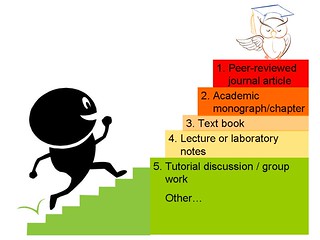Educational practice is littered with myths that have permeated over the years and have not gone away. A particular example that is evident in most countries is the habit of wrongly identifying the differences between students- ‘right-brained’ or left-brained; ‘global’ or ‘holistic’; ‘visual’-, ‘auditory’- or ‘kinaesthetic’-learners. The latter is what this article will focus on as it has been found that there is a poor application of this Visual, Auditory, Kinaesthetic learning styles (VAK) theory, particularly in the UK. The Times Educational Supplement (2005) found that the UK’s Department of Education over-emphasise the importance of the VAK model in classrooms and that schools need to provide evidence of using a multitude of ways of teaching to accommodate students’ learning styles.
A BRIEF BACKGROUND ON VAK
The idea that individuals are either visual, auditory or kinaesthetic learners is probably familiar to most educators and students. This theory suggests that despite our ability to be able to receive information through different senses, we have a preference, i.e. some people prefer seeing, some like hearing, while some prefer kinaesthesia (the sensation that tells us where our bodies are). When learning anything new, visual learners prefer diagrams, drawings or printed words. Auditory learners prefer to hear songs or descriptions or anything they can listen to. Kinaesthetic learners on the other hand like to hold and use objects and/ or move their bodies.
FACTS AND WHAT THE FACTS?!?
It has long been established that people differ in their visual and auditory memory abilities. Our brains can store what something looks like and what they sound like. When asked to describe the physical properties of our sofa or bed, we tend to use our visual memory to recall what they look like and what they are made of. But when asked who the better singer is between Bruno Mars or John legend, we tend to use our auditory memory to recall how each of them sings. The difference between one person to the next is the amount of detail each of their memories are able to hold. Some people’s brains are able to store detailed and vivid visual and/ or auditory information, while some cannot.
I should also point out that our memories are not solely visual and auditory. We also remember meanings. Just recall the recent story you have read or heard. You may not remember it word for word, but I am certain that you will remember its meaning. In other words, meaning has a ‘life’ of its own.
PROBLEMS WITH VAK
The whole of learning styles studies and practice (not just VAK) lack theoretical underpinning which can reliably explain the whole discipline and its claims (Hay & Kinchin, 2006). While the differences between people’s auditory and visual memory abilities and capacities are very well supported in academic literature, they do not support the VAK theory. I must remind you that the theory’s key assumption is that individuals will learn better when the instruction and/ or information is presented in a way that matches their cognitive style. For instance, imagine two fictitious students Bob and Sam. Let us pretend that Bob is a visual learner and Sam is an auditory learner. Imagine also that I gave both of them two sets of new words and their corresponding definitions to learn- one presented as a written list whilst the other was a presented through a voice recorder that the students have to listen to. The theory suggests that Bob would learn the first list better than Sam and that the opposite would be true for the second list.
Hundreds of similar studies have been conducted and have found what the theory predicted, which is that students like Bob learned the first list better than students like Sam. However, I would claim that tests (and results) such as the one described do not support the theory simply because they do not test auditory and visual memories. One should note that even though the information is presented through auditory and visual media, what’s being tested is the meaning of the words. Using visual and auditory memories purely will not help anyone to recall meanings of words.
I must acknowledge that there are some lessons and topics wherein students must depend on either visual or auditory memories. For instance, visual memory is used to memorise how shapes look like while auditory memory is used to store and recall what a guitar sounds like. However, the vast majority of learning relies on students’ ability to learn, store and recall meaning, as well as sights, feelings and sounds.
ASSESSMENTS- another big problem
While it is all very well (to some extent) that schools encourage teachers to teach students in a variety of ways based on their learning styles or memory use, they are still assessed in the same old way. Everybody gets assessed in the same way. In most cases, students are given the exact same test papers or practicals.
DOES THIS MEAN THAT THE VAK THEORY IS SLIGHTLY RIGHT?
NO. We must acknowledge that proponents of the VAK theory claim that the same material should be presented in different ways to ensure that each student’s preferred style is matched. For instance, when learning about a country’s map, teachers should present visual learners with a printed map and written descriptions of it, while the auditory learners should listen to an audio recording of someone verbally describing the features of the map. Kinaesthetic learners on the other hand could be asked to create a model of the map. While this approach may work when learning a map, I assume (and know from experience) that this would not work in guitar lessons.
I agree with Coffield et al. (2009) when they condemned champions of ‘learning styles’ theories for pigeon-holing students unnecessarily using unreliable and poorly validated tests. I have witnessed experienced teachers administer VAK questionnaires to unsuspecting secondary and primary-school students and then labelled them using the results they have collated. I am also aware that some schools send teachers on a one-off ‘learning-styles’ training day. This is problematic as one-day trainings are insufficient to learn and critique any theory. Also, some of them are forced to apply these poorly tested theories by their head teachers despite their reluctance to do so.
WHY DOES IT SEEM SO RIGHT EVEN IF IT IS WRONG?
Most teachers and educational professionals believe that this theory is correct and here’s why I think that is:
- It has become common wisdom– i.e. everybody believes it, therefore it must be true.
- It is true that we all differ in visual and auditory memories. One may suggest that the child who is able to draw a building accurately after seeing it only a few times is a visual learner, whereas in fact, she has a better-than-average visual memory. Having a great visual memory is NOT the same as being a visual learner.
- Confirmation bias– we unconsciously interpret situations as being consistent with our beliefs.
USING DIFFERENT ‘STYLES’
Hodgkinson and Saddler-Smith (2003) have shown through research that it is possible for the same students to use different learning styles in different situations and lessons. They have also shown that it is possible for students to learn and strengthen their use of their non-preferred learning style in order to counter-balance their preferences.
SO WHAT NOW?
I believe that the way forward is to abandon most people’s unsupported beliefs about learning styles. The theories have not been supported by research and practical applications. However, I would still urge teachers to be creative and present information in different modalities- not to suit anybody’s learning styles, but in order to promote attention and engagement. We should know that any change in routine will catch us out. If a teacher has been talking for 25 minutes, chances are that most of the students in the class will get bored and lose their concentration. Putting on a video or getting them to do an activity that requires kinaesthesia would be a welcome change. Also, instead of individualising the required mental processes for each student, I urge teachers to let all of your students to practise learning and retaining information using different modalities or ‘styles’.
Lastly, although this point is almost out of teachers’ hands, students’ attainment should come from a multitude of assessment techniques and not only pen and paper ones. I must admit that this has been happening for a good few years now but I feel that more should be done.
ONE LAST THING…
 In my opinion, the learning styles myth and the way it has spread highlights the growing concern in teachers’ knowledge of up-to-date research findings. Fresh graduates are often well equipped with the latest research findings and new exciting ways of teaching. But some (including Coffield, 2014 and I) have observed that the longer some teachers have been in their profession, the lesser they know about recent publications. It is important to keep up with the research in order to refresh one’s approach. It is also likely that what we know now may not be supported by research that will be conducted in the future. I would also add that it is not enough to read textbooks as most of what is written in one will be about 2 years old. Peer-reviewed journal articles are always the best source of information. In contrast to books, published peer-reviewed journals are carefully scrutinized and approved by a group academics and researchers.
In my opinion, the learning styles myth and the way it has spread highlights the growing concern in teachers’ knowledge of up-to-date research findings. Fresh graduates are often well equipped with the latest research findings and new exciting ways of teaching. But some (including Coffield, 2014 and I) have observed that the longer some teachers have been in their profession, the lesser they know about recent publications. It is important to keep up with the research in order to refresh one’s approach. It is also likely that what we know now may not be supported by research that will be conducted in the future. I would also add that it is not enough to read textbooks as most of what is written in one will be about 2 years old. Peer-reviewed journal articles are always the best source of information. In contrast to books, published peer-reviewed journals are carefully scrutinized and approved by a group academics and researchers.



























































































